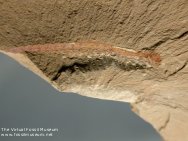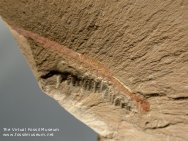Cardiodictyon
catenulum
Superphlum
Lophotrochozoa; Phylum Lobopodia
Geological
Time: Early Cambrian (~525 million years ago)
Size: Cardiodictyon:
26 mm long
Fossil
Site: Chengjiang Maotianshan Shale - Quiongzhusi Section, Yu’anshan
Member, Heilinpu Formation, Mafang, Anning, Kunming , Yunnan Province,
China
 The
Lobopodians are small marine and terrestrial animals colloquially
called “velvet worms” or “worms with legs”.
While all Recent forms are terrestrial, most fossil The
Lobopodians are small marine and terrestrial animals colloquially
called “velvet worms” or “worms with legs”.
While all Recent forms are terrestrial, most fossil  Lobopodians
are marine, and are known primarily from the Cambrian. Six named
genera, each with a single species, are known from the Chengjiang
Biota, making it the richest source of fossils of the type on Earth.
This is one of the most striking, and quite rare. As of 2004, well
less than 100 specimens were known. A complete Cardiodictyon possesses
23 – 25 angular paired sclerites, each pair of which is associated
with a pair of legs. Each leg has curved claws that are thought
to have served the creature as an adaptation for crawling on other
organisms. Cardiodictyon is most closely related to Aysheaia from
the younger Burgess Shale, and is unknown outside of Yunnan Province.
This fine example has incredible detail, with most of the myriapod
- like legs clearly evidence. The animals head is similarly well
preserved. Lobopodians
are marine, and are known primarily from the Cambrian. Six named
genera, each with a single species, are known from the Chengjiang
Biota, making it the richest source of fossils of the type on Earth.
This is one of the most striking, and quite rare. As of 2004, well
less than 100 specimens were known. A complete Cardiodictyon possesses
23 – 25 angular paired sclerites, each pair of which is associated
with a pair of legs. Each leg has curved claws that are thought
to have served the creature as an adaptation for crawling on other
organisms. Cardiodictyon is most closely related to Aysheaia from
the younger Burgess Shale, and is unknown outside of Yunnan Province.
This fine example has incredible detail, with most of the myriapod
- like legs clearly evidence. The animals head is similarly well
preserved.
Also
see: Living fossils
|
|




